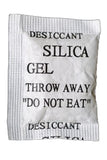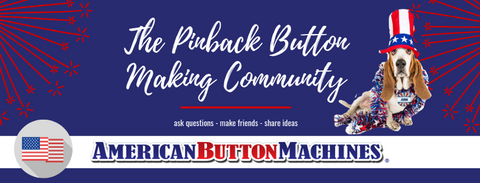Why Does My Button Have Rust? Button Making Questions, Ask ABM
Why does my button have rust on it? This question comes up more often as the weather begins to warm up and humidity begins to rise. You remember you have a great stash of super cute buttons that you put away at the end of last Summer and you run to get them out of the back of the closet only to find those perfect tropical beach designs have a few unexpected polka dots. Although it's a little too late for that group, you can absolutely prevent it from happening to the rest!
 Moisture, any kind of moisture, is the mortal enemy of button makers everywhere and sometimes it shows up in the most unexpected ways and places. The first tip to avoid any unpleasant surprises is to be sure if you are using an inkjet printer that you let your ink dry completely. I know it's hard to wait to press that super adorable button you just designed but you have to resist the urge for the greater good. If you can let them dry overnight that is even better. If there is any moisture, even a tiny bit, left in the ink you will eventually see rust.
Moisture, any kind of moisture, is the mortal enemy of button makers everywhere and sometimes it shows up in the most unexpected ways and places. The first tip to avoid any unpleasant surprises is to be sure if you are using an inkjet printer that you let your ink dry completely. I know it's hard to wait to press that super adorable button you just designed but you have to resist the urge for the greater good. If you can let them dry overnight that is even better. If there is any moisture, even a tiny bit, left in the ink you will eventually see rust.
Next up, taking your buttons out on field trips! This can be especially tricky. Even when you have them in one of those great plastic totes we all love and live by, they are not truly protected. You start in a nice cool house then out in the heat to get to the car. The a/c kicks back on when you crank the engine and everything is cool and happy again. Then you arrive at your destination and it's back into the heat. Then to get the few stragglers you have left back home you have to repeat the process in reverse. All of those temperature changes lead to condensation inside of those handy containers which means moisture which leads back to rust.
 Any time you will be storing your buttons or taking them in and out of temperature
Any time you will be storing your buttons or taking them in and out of temperature changes try throwing in some of those great silica packets you find in so many things these days. It's a great way to re-purpose those little packets or you can also purchase them, as well as many other moisture absorbers, very economically at a lot of stores. Another simple solution is uncooked dry rice. It works fabulously as a moisture magnet!
changes try throwing in some of those great silica packets you find in so many things these days. It's a great way to re-purpose those little packets or you can also purchase them, as well as many other moisture absorbers, very economically at a lot of stores. Another simple solution is uncooked dry rice. It works fabulously as a moisture magnet!
Just remember this simple formula to ensure your continued button bliss: steel + moisture = rust. Until next time, happy button making!
By Brighid Brown, Director of Blogging and All Things Cool at ABM
Share this post
5 comments



Hi, Tomaka! Our machines are solid US steel. The key to avoiding rust on steel is to avoid moisture. If you will be storing your machine or your button components for a period of time, try adding a silica packet to the box to absorb excess humidity and moisture.
I have a question about the actual dye to the badge maker. It may be the same concept, but how do I actually prevent rust on the dyes of my badge maker?
Thank you in advance & Happy New Year!!
Hi, Dan! It sounds like maybe the ink was not completely dry when the buttons were pressed and allowed for moisture to be trapped inside. Printers and inks have certainly changed over the last 30 years and something in the newer inks is more than likely the culprit.
That’s a viable solution for storing bulk buttons etc, but as a person who has bought and worn buttons for decades I can say that this seems to be kind of a new thing with buttons. I have dozens that I wore in the 80’s and while they may have a little rust on the back, NONE of them have rust stains coming thru on to the image. Yet I’ve had to replace newer buttons, many of which I never even had the chance to wear on a yearly basis because the rust stains destroy the image. It used to be that I’d put my buttons on an American flag I had on my wall and they’d be ready to go when I was ready to wear them, but if I do that with newer pins they are ruined without ever being touched, yet the 30 plus year old pins are absolutely beautiful. What has changed in the manufacturing process that causes this? What can I do as a consumer to prevent it, without having to become a freak about taking them off and storing them in dessicant every time I want to wear one? It seems to me it’s got little to do with storage and a lot more to do with how companies are making them. If buttons that are decades old are still holding up, but every single one I bought last year has been ruined by rust stains, then what about the process has changed? The metal parts don’t really display rust it seems like it only develops between the image and the back as a stain that bleeds. I’m about to replace a couple buttons I really love for the third time the images are crisp and clear, there’s nothing about these pins that appears poorly done or of bad quality. There’s got to be a way to keep these looking nice! Any ideas?
Thanks,
DS
This is great information. I just discovered rust on some of my buttons, I’m definitely guilty of not waiting long between printing & pressing. Thank you for the tips!